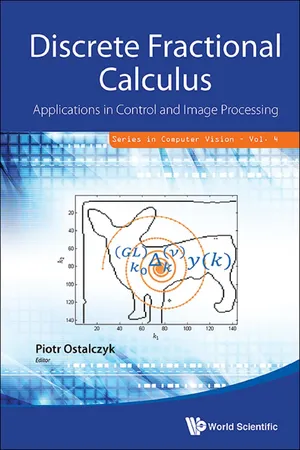
Discrete Fractional Calculus: Applications In Control And Image Processing
Applications in Control and Image Processing
- 396 pages
- English
- ePUB (mobile friendly)
- Available on iOS & Android
Discrete Fractional Calculus: Applications In Control And Image Processing
Applications in Control and Image Processing
About This Book
The main subject of the monograph is the fractional calculus in the discrete version. The volume is divided into three main parts. Part one contains a theoretical introduction to the classical and fractional-order discrete calculus where the fundamental role is played by the backward difference and sum. In the second part, selected applications of the discrete fractional calculus in the discrete system control theory are presented. In the discrete system identification, analysis and synthesis, one can consider integer or fractional models based on the fractional-order difference equations. The third part of the book is devoted to digital image processing.
The main subject of the monograph is the fractional calculus in the discrete version. The volume is divided into three main parts. Part one contains a theoretical introduction to the classical and fractional-order discrete calculus where the fundamental role is played by the backward difference and sum. In the second part, selected applications of the discrete fractional calculus in the discrete system control theory are presented. In the discrete system identification, analysis and synthesis, one can consider integer or fractional models based on the fractional-order difference equations. The third part of the book is devoted to digital image processing.
Readership: Researchers, academics, professionals and graduate students in pattern recognition/image analysis, robotics and automated systems, systems engineering and mathematical modeling.
Frequently asked questions
Information
Chapter 1
Discrete-variable real functions
1.1Notation















1.2Class of one discrete-variable functions



Table of contents
- Cover page
- Copyright page
- Title page
- Preface
- Contents
- List of Figures
- List of Tables
- 1. Discrete-variable real functions
- 2. The n-th order backward difference/sum of the discrete-variable function
- 3. Fractional-order backward differ-sum
- 4. The FOBD-S graphical interpretation
- 5. The FOBD/S selected properties
- 6. The FO dynamic system description
- 7. Linear FO system analysis
- 8. The linear FO discrete-time fundamental elements
- 9. FO discrete-time system structures
- 10. Fractional discrete-time PID controller
- 11. FOS approximation problems
- 12. Fractional potential
- 13. FO image filtering and edge detection
- Appendix A Selected linear algebra formulae and discrete-variable special functions
- Bibliography
- Index